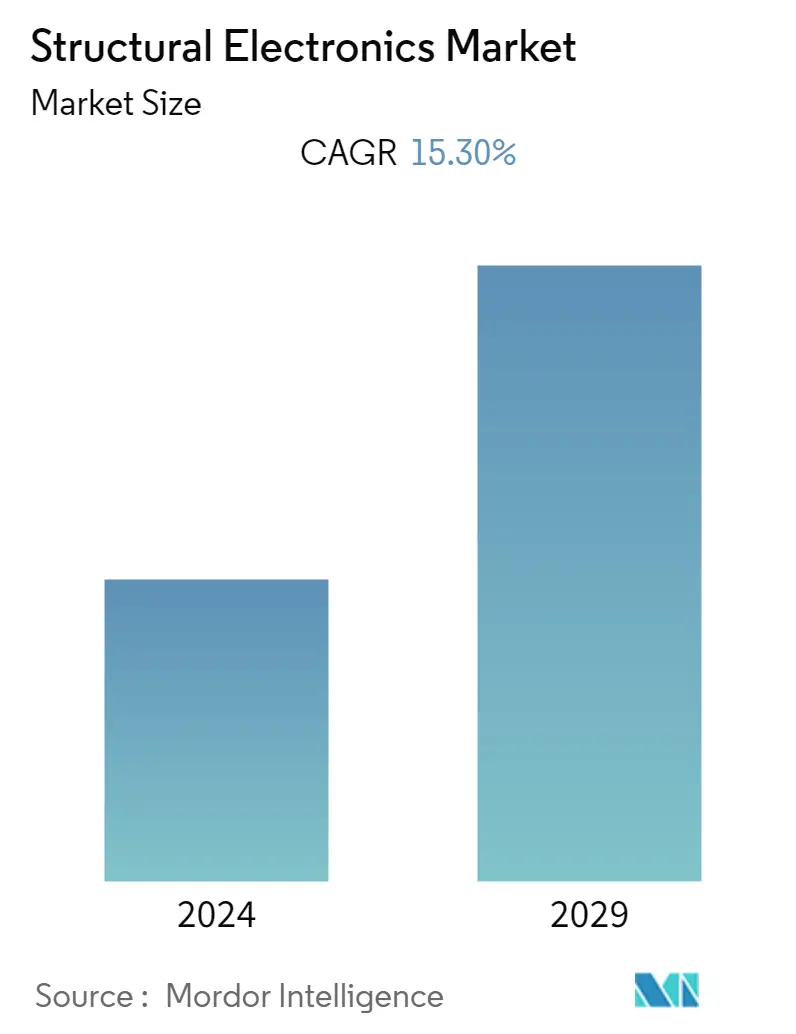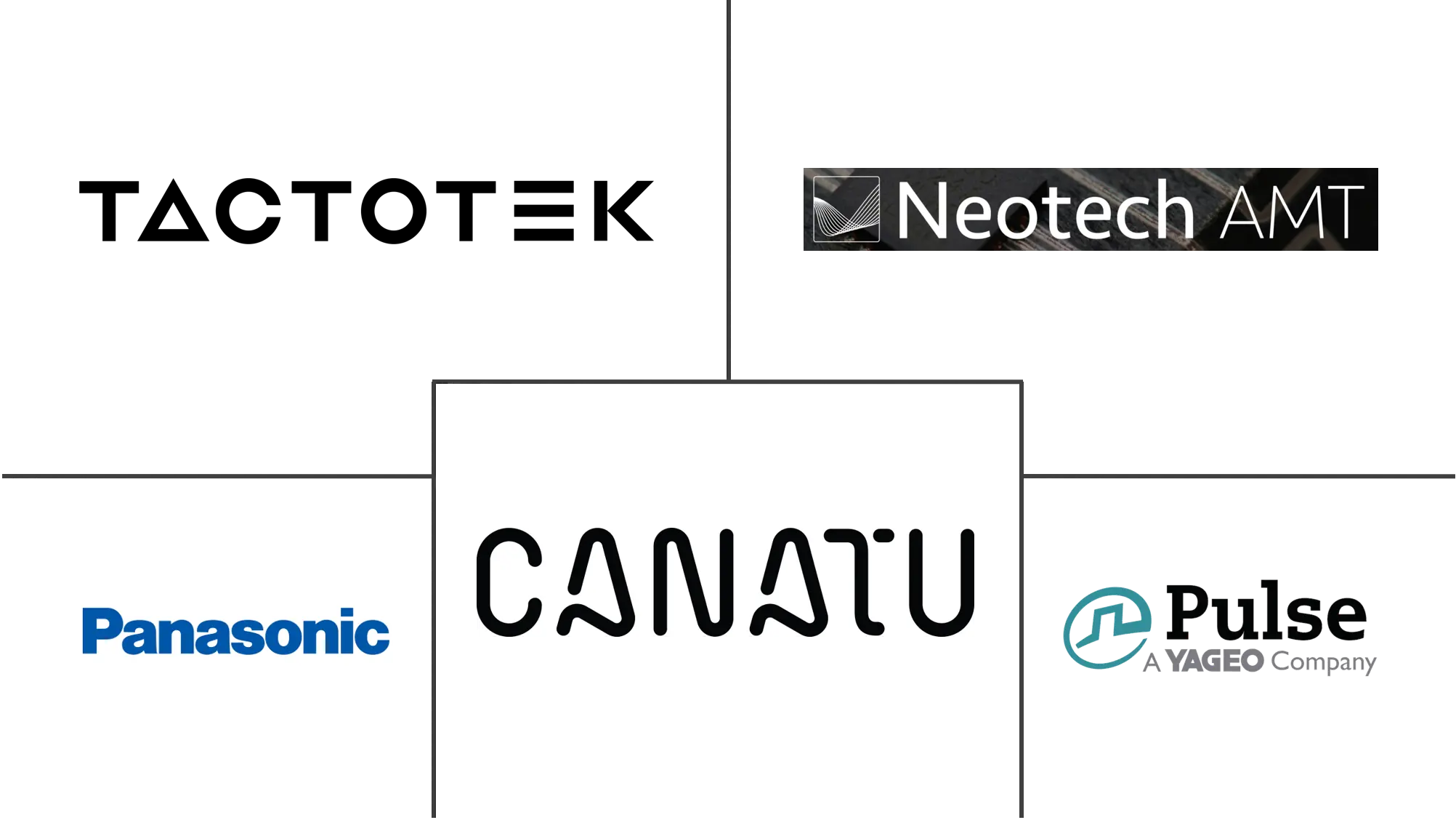Market Size of Structural Electronics Industry

| Study Period | 2019 - 2029 |
| Base Year For Estimation | 2023 |
| CAGR | 15.30 % |
| Fastest Growing Market | Asia Pacific |
| Largest Market | North America |
| Market Concentration | High |
Major Players
*Disclaimer: Major Players sorted in no particular order |
Structural Electronics Market Analysis
The structural electronics market is expected to register a CAGR of 15.3% during the forecast period (2021 - 2026). Improvements in 3D technology and the rise of IoT are the factors fueling the growth of structural electronics market. Additionally, there is an increase in the demand for lightweight, cost-effective, and compact products. Structural electronics offer these advantages, thereby augmenting their usage in a wide range of applications.
- Structural electronics are replacing the old components-in-a-box approach with smart materials, such as smart skin, load-bearing parts, and e-textiles. The key capability of structural electronics is to reduce the weight of the product and is expected to disrupt the automotive and aerospace sectors.
- Advancements in material science to develop stretchable conductive materials, application diversity, and government funding are expected to play important roles in driving the advancements in the structural electronics industry.
- For instance, one of the largest Japanese car companies experimented with a 3D printing of ultra-lightweight vehicle seats based on bird-bone structure. The car is expected to become the first 3D-PE (3D Printed Electronics) with electrics and electronics built into the seat.
- However, the lack of technological awareness might hamper the growth of the market during the forecast period.
Structural Electronics Industry Segmentation
The term, structural electronics (SE), refers to a next-generation based electronics technology, which involves the printing of functional electronic circuitries, across irregular-shaped architectures. SE is expected to replace bulky load-bearing structures within a circuitry with smart electronic components that can conform to complex shapes for ensuring optimum space utilization. SE offers different and better ways of implementing electronic functionalities into the products.
| By Application | |
| Automotive | |
| Aerospace | |
| Consumer Electronics | |
| Healthcare | |
| Other Applications |
| Geography | |
| North America | |
| Europe | |
| Asia-Pacific | |
| Rest of the World |
Structural Electronics Market Size Summary
The structural electronics market is poised for significant growth, driven by advancements in 3D technology and the increasing integration of IoT. This market is characterized by the transition from traditional components-in-a-box designs to innovative smart materials like smart skin and e-textiles, which offer benefits such as reduced weight and enhanced functionality. These attributes are particularly advantageous in sectors like automotive and aerospace, where lightweight and compact solutions are in high demand. The development of stretchable conductive materials and diverse applications, supported by government funding, is expected to further propel the industry. However, the market faces challenges, including a lack of technological awareness, which could impede its growth trajectory.
North America is a key region in the structural electronics market, benefiting from substantial investments in advanced technologies and a high adoption rate in high-end vehicles and space applications. The region's focus on electric vehicles, which increasingly utilize structural electronics, is expected to drive market expansion. The market is highly consolidated, with major players like The Boeing Company and Panasonic Corporation dominating due to the sophisticated nature of the technology, which poses entry barriers for new entrants. Strategic partnerships, such as those between BÖ-LA and TactoTek, are enhancing the integration of electronic functionalities within molded plastics, further advancing the market. Despite challenges like supply chain disruptions from the global pandemic, the demand for structural electronics is anticipated to grow, fueled by the ongoing adoption of IoT and 3D technologies across various industries.
Structural Electronics Market Size - Table of Contents
-
1. MARKET DYNAMICS
-
1.1 Market Overview
-
1.2 Industry Attractiveness - Porter's Five Force Analysis
-
1.2.1 Bargaining Power of Suppliers
-
1.2.2 Bargaining Power of Buyers/Consumers
-
1.2.3 Threat of New Entrants
-
1.2.4 Threat of Substitute Products
-
1.2.5 Intensity of Competitive Rivalry
-
-
1.3 Industry Value Chain Analysis
-
1.4 Technology Snapshot
-
1.4.1 Technology Framework and Roadmap
-
1.4.2 Innovations
-
1.4.3 In-mold Electronics and Functional Materials
-
-
1.5 Market Drivers
-
1.5.1 Emerging Need for Lightweight, Compact, Cost-effective Products
-
1.5.2 Improvements in 3D Technology
-
-
1.6 Market Restraints
-
1.6.1 Lack of Technological Awareness
-
-
1.7 Assessment of Impact of Covid-19 on the Industry
-
-
2. MARKET SEGMENTATION
-
2.1 By Application
-
2.1.1 Automotive
-
2.1.2 Aerospace
-
2.1.3 Consumer Electronics
-
2.1.4 Healthcare
-
2.1.5 Other Applications
-
-
2.2 Geography
-
2.2.1 North America
-
2.2.2 Europe
-
2.2.3 Asia-Pacific
-
2.2.4 Rest of the World
-
-
Structural Electronics Market Size FAQs
What is the current Structural Electronics Market size?
The Structural Electronics Market is projected to register a CAGR of 15.30% during the forecast period (2024-2029)
Who are the key players in Structural Electronics Market?
TactoTek Oy., Panasonic Corporation, Canatu Oy, Neotech AMT GmbH and Pulse Electronics (a Yageo Company) are the major companies operating in the Structural Electronics Market.

